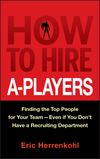How to Hire A-Players: Finding the Top People for Your Team- Even If You Don't Have a Recruiting Department
 How to Hire A-Players: Finding the Top People for Your Team- Even If You Don't Have a Recruiting DepartmentISBN: 978-0-470-56224-6
Hardcover
240 pages
April 2010
This is a Print-on-Demand title. It will be printed specifically to fill your order. Please allow an additional 10-15 days delivery time. The book is not returnable.
Learn more about this book
|
|||||||
“Stop Making Bad Hires: 8 Steps for Improving Any Interview Process”
by Eric Herrenkohl
1. Determine an A-Player Profile. In my new book How to Hire A-Players, I ask the question: would you know an A-player if you met one? How so? What would tell you that an individual you currently employee or that someone you are interviewing is an A-player? I know this sounds obvious, but you would be surprised at the lack of clarity within companies about the profile of an ideal candidate. If you don’t know exactly who you are looking for, you and your team will be slow to agree upon and actively pursue the right people.
2. Look for overall patterns of accomplishment. The best way to reduce hiring mistakes in an interview is to get a very clear picture of someone’s overall pattern of accomplishments in their life and career. Then, compare that pattern to your A-Player Profile for the role. Unlike mutual funds, with people past performance is the best indicator of future results.
3. Ask initial screening questions to weed out unqualified people. For example, some roles require that applicants have certain software expertise or industry experience. If you can’t determine this from the resume, ask about these abilities early in a phone screen. If someone does not meet these minimum criteria, they are eliminated and the phone interview is over.
4. Starting with their most recent role, confirm their dates of employment, including both the month and the year. People often fudge these dates – you want to verify them.
5. For each role, ask questions specifically designed to dig into their accomplishments. The best overall question to ask is: Please tell me briefly about the top accomplishments for which you were personally responsible while employed in this role?
6. Ask follow-up questions that keep the candidate talking. These questions include: How did you do that? Why so? Please tell me how you made that happen? What were the most important steps you took to make that happen? Such open-ended questions dig beneath a candidate’s initial, pre-planned answers and programmed responses to find out what he or she really did.
7. Take verbatim notes: I have found that jotting down the word-for-word responses that people provide during interviews is helpful. When you go back and look at your notes, those verbatim quotes will help you to recall the person’s strengths and weaknesses.
8. Score each candidate: Create a scorecard for yourself using the A-Player Profile that you created. Give candidate’s a score for each key area in the profile as well as an overall score. This helps you to objectively compare and contrast the strengths and weaknesses of all the people you interview.






